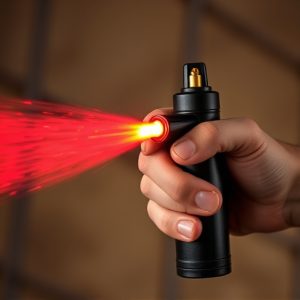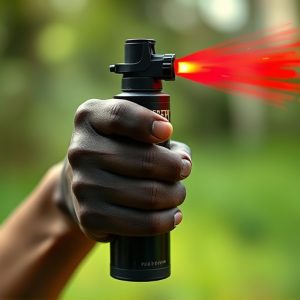Mastering Pepper Spray Safety: From Composition to Eye Washing Procedure
The Pepper Spray Eye Washing Procedure is a crucial step after deploying pepper spray, flushing eyes…….
The Pepper Spray Eye Washing Procedure is a crucial step after deploying pepper spray, flushing eyes with clean water for 15+ minutes to prevent irritation and damage from capsaicin. This simple act ensures quicker recovery and avoids long-term eye issues. As pepper spray is legally recognized in many regions as a self-defense tool, understanding local laws and adhering to this procedure is essential for responsible use and avoiding legal trouble. Key features of civilian defense pepper sprays include range, pattern, active ingredient concentration (SCU), and safety features like holsters and automatic shut-off mechanisms.
In today’s world, civilian defense pepper spray is a powerful tool for personal safety. This comprehensive guide explores its effectiveness and crucial role in self-defense strategies. We delve into the science behind pepper spray, its composition, and how it works to incapacitate assailants. From a legal perspective, we navigate the rules and regulations surrounding its use. Additionally, this article provides an essential step-by-step guide on proper pepper spray eye washing procedures. Lastly, we help you choose the right product by highlighting key features and considerations for purchase.
- Understanding Pepper Spray: Its Composition and Effectiveness
- The Role of Pepper Spray in Civilian Defense: A Legal Perspective
- Safe Handling and Application: Step-by-Step Eye Washing Procedure
- Choosing the Right Product: Key Features and Considerations for Purchase
Understanding Pepper Spray: Its Composition and Effectiveness
Pepper spray, a powerful self-defense tool, is a compound designed to incapacitate an attacker temporarily. Its primary active ingredient is capsaicin, the same chemical that gives chili peppers their heat and sting. This irritant triggers nerve endings in the eyes, nose, and respiratory system, causing severe discomfort, reduced visibility, and difficulty breathing. The effect is swift, often lasting only a few minutes, but it’s enough time for an individual to escape or disable their assaulter.
When using pepper spray, understanding the eye-washing procedure is crucial for safety. After deployment, eye irritation and potential damage can occur if not washed out properly. The Pepper Spray Eye Washing Procedure involves immediately flushing the eyes with clean water for at least 15 minutes, ensuring all residual spray is removed. This simple yet effective step can prevent long-term eye issues and promote quicker recovery.
The Role of Pepper Spray in Civilian Defense: A Legal Perspective
In many regions, pepper spray is recognized as a legitimate self-defense tool for civilians. From a legal standpoint, its use is often governed by specific regulations that balance an individual’s right to protect themselves with public safety and order. The primary mechanism of action for pepper spray involves irritating the eyes and respiratory system, temporarily disabling an aggressor. This provides users with crucial time to escape or defuse a potentially dangerous situation.
When used responsibly, pepper spray can serve as an effective deterrent against physical assault. However, it’s essential that users understand the eye washing procedure following exposure to minimize harm and ensure compliance with legal requirements. Proper training and knowledge of local laws are indispensable for civilians considering pepper spray as a defense mechanism, ensuring its legitimate application while avoiding potential legal repercussions.
Safe Handling and Application: Step-by-Step Eye Washing Procedure
Safe Handling and Application: Step-by-Step Pepper Spray Eye Washing Procedure
Proper handling and application of civilian defense pepper spray are crucial to ensure its effectiveness and minimize potential harm. Before using any pepper spray, it’s important to follow a strict eye washing procedure. Start by immediately flushing the affected eyes with clean, cool water for at least 15 minutes. Hold the eyes open gently using a clean hand or cloth to prevent them from closing, allowing continuous water flow over the irritated area.
For the step-by-step process, first position yourself away from the spray mist to avoid re-inhalation. Next, gently wash your hands with soap and water to eliminate any residual pepper spray. Then, using clean eye wash or a slow stream of cool running water, irrigate both eyes thoroughly. Ensure that the solution flows over the inside and outside of each eye, including the eyelids. Continue flushing until you’ve removed all traces of the irritant, providing comfort and relief from the burning sensation.
Choosing the Right Product: Key Features and Considerations for Purchase
When selecting a civilian defense pepper spray product, understanding key features and considerations is essential for ensuring its effectiveness and safety. One crucial aspect to look for is the spray range – how far the spray can reach and disperse to neutralize an attacker. A longer range provides more space for escape and self-defense. Additionally, consider the spray pattern; a wide, even spray ensures maximum coverage, enhancing your defense against multiple assailants.
The type of pepper spray active ingredient is another vital factor. Capsaicin, the primary irritant in pepper spray, comes in various concentrations measured in SCU (spray concentration units). Higher SCU levels offer more potent protection but may require proper training for safe and effective use. Always check the Pepper Spray Eye Washing Procedure instructions to ensure proper handling and minimize exposure risks. Look for products that include safety features like a built-in holster, a lanyard for easy carry, and an automatic shut-off mechanism to prevent accidental discharge.
Pepper spray, when used responsibly, can be a powerful tool for civilian defense. Understanding its composition, legal considerations, and proper handling—including a meticulous eye washing procedure—is crucial for ensuring safety and effectiveness. By following the step-by-step guide outlined in this article, individuals can make informed decisions when purchasing pepper spray products, ultimately empowering themselves to protect against potential threats. Remember, knowledge and preparation are key to staying safe.


